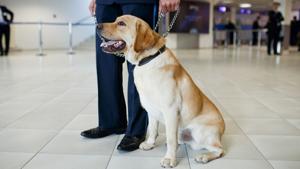
Late last year, the United States Department of Transportation revised their definition of service animals to closer align with the description outlined by the Americans with Disabilities Act. This eliminated pets classified as “emotional support animals.”
Traditional service dogs for those with eye or hearing impairments still qualify. So do psychiatric service dogs (PSDs). That’s good news for the 6% of Americans who suffer from PTSD, according to The National Center for Post-Traumatic Stress Disorder (PTSD).
Service dogs are reliable companions for people with disabilities and those with PTSD, providing hope and real change.
Shannon Walker, CEO & Founder of Northwest Battle Buddies, notes the positive impact of service dogs on veterans with PTSD. “Along with the many amazing ways service dogs can mitigate the symptoms of PTSD, an incredible benefit to becoming more comfortable in public and feeling safer is to start traveling. It is amazing to see Veterans living their life with more freedom and independence and turning what they once ‘dreamed’ about into actual ‘memories.’”
Expert Tips When Traveling With a Service Dog
When planning to travel with your service animal, whether via air or road trip, ensuring a stress-free journey is key. With these essential tips, you can make your trip smooth and comfortable, making your experience fail-proof.
1. Early Contact With Airlines
When flying, reach out to the airline well in advance to ensure a smooth journey with your service dog. Complete any Department of Transportation forms necessary. Airline policies vary, so it’s important to get their specific guidelines.
Connie Edwards is a permanently disabled Navy Veteran and travels often with her service dog. “I have to fill out an NTSB form attesting that he is a trained service dog, acknowledging my duties as a service dog handler. Do your research ahead of time on the airline’s requirements, the destination’s requirements, and the plane’s measurements. Not every airline has the same requirements.”
2. Dress for Identification
Certify your companion and equip them with appropriate identification, such as vests, harnesses, and tags. These visual indicators are important for helping airline staff identify your service dog.
Edwards explains, “We have a TSA Precheck. We go through the TSA for the ID check. I take his vest and collar off and loop his lead around his neck. I put him in a ‘down’ where he lays down just off the mat before the metal detector.” She continues, “We travel at least twice a year by air. We have never run into a problem with the TSA, and it seems as if they enjoy watching him work!”
3. Ensure Proper Training
You should know that your dog is well-trained and behaves appropriately in public spaces. Airlines do have the right to deny transport if your service dog exhibits disruptive behavior, poses a safety risk, or is perceived as a threat to others.
Edwards points out, “Our dogs undergo a minimum of 360 hours in professional training including going through TSA, walking in congested areas, escalators and elevators, shuttle trains and public transit, ‘heeling’ when I have a rolling carry-on, not getting spooked by other passengers and their bags, staying in line next to me, and holding his body functions until it’s the proper time to relieve himself.”
4. Inform Accommodations
During the accommodation booking process, make it clear that a service dog will accompany you. Ensure the hotel staff knows you’re staying at the property with a dog and communicate any specific needs for you and your furry companion.
Early communication allows hotels to make necessary preparations, whether providing specific room arrangements, offering accessible amenities, or understanding any special considerations. Taking this initiative facilitates an easier travel experience for yourself. It contributes to raising awareness about the importance of service dogs, encouraging the hospitality industry to recognize and support the needs of individuals with service animals.
5. Prepare for Emergency
Developing an existing emergency plan is crucial for travelers with service dogs. Include local vet contacts in your plan and be aware of nearby pet-friendly facilities. With this approach, you are well-prepared to handle unforeseen situations that require an emergency approach.
Edwards adds, “I have a lot of anxiety I have to deal with when I fly. Chief reminds me to check in with myself and use calming strategies like removing myself from heavily populated areas, deep pressure therapy by sitting close to me or in my lap if I’m on the floor, and asking to be pet, which calms both of us down.”
6. Prioritize Comfort
Make your service dog’s comfort a top priority during travel. An informative tip from Edwards to prepare for your travels, “I bring 3 days of dog food and an empty waterer bottle for him in my backpack, a collapsible bowl, poop bags, and Swiffer wipes in case he has a urine or vomit accident. He has never had an accident, but I like to carry it just in case.”
Before the trip, opt for light feeding to prevent discomfort. Pack essential items such as water, food, medications, and travel-friendly gear to ensure your companion’s well-being throughout the journey. A well-fed, hydrated service dog will likely remain calm and content during travel.



